The Economics and Statistics Division maintains archives of previous publications for accountability purposes, but makes no updates to keep these documents current with the latest data revisions from Statistics Canada. As a result, information in older documents may not be accurate. Please exercise caution when referring to older documents. For the latest information and historical data, please contact the individual listed to the right.
<--- Return to Archive
For additional information relating to this article, please contact:
June 27, 2023VALUE ADDED IN EXPORTS, 2019 Statistics Canada has updated its estimates of value added and employment embodied in Canadian exports.
Value-added represents the contribution of labour and capital to the production process. Its components are labour income, gross operating surplus (or profits and depreciation) and taxes net of subsidies on production. The sum of value-added by all industries plus taxes net of subsidies on products is equal to GDP.
Exports only generate income (GDP) within Nova Scotia when value is added to either the domestically-produced or imported outputs. However, exports are typically reported on a gross basis, including the cost of imported inputs. Statistics Canada’s supply and use tables allow for the calculation of the proportion of exports that represent value added, and therefore, income generated within the provincial economy.
Statistics Canada's estimates calculate a value added amount within each sector that generates the exports. Statistics Canada further estimates the amount of value added created by upstream sectors within a province that supply an exporting sector. Statistics Canada also estimates the number of jobs associated with exports - both within exporting sectors and upstream sectors that supply them.
These estimates allow examination of the relative significance of trade for each province and sector. As the data are constructed using supply and use tables, there is a considerable lag in their production and they have only been updated to 2019 (along with revisions to prior years).
Overall, Nova Scotia's economy generates the least amount of exports (scaled to total employment in all industries) at $17,186 per worker. This value is up 10.9% from 2018, the fastest growth in exports per worker among all provinces.
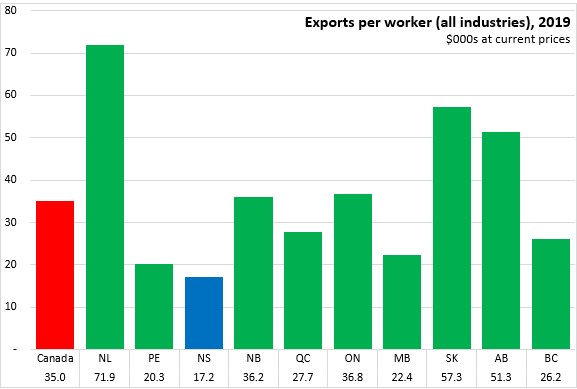
Resource-producing provinces (Newfoundland and Labrador, Saskatchewan, Alberta) still have the largest export values per worker, and these values have recovered from 2015 and 2016 as oil prices rebounded. Exports per worker were down in Québec, Manitoba and British Columbia.
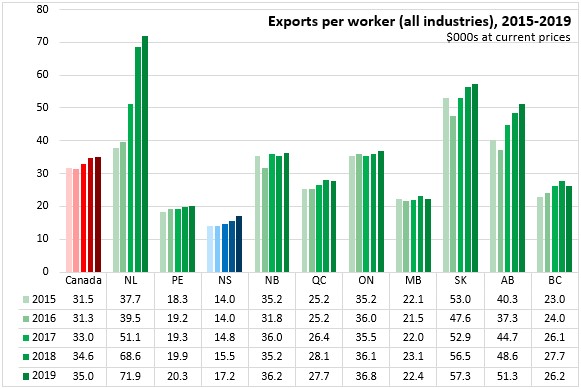
Of the total value added in the economy, Nova Scotia relies the least on exports to generate value added, with 11.0% of provincial value added (ie: GDP) accounted for by value added in exports (either directly or in upstream in supplier industries within the province). Newfoundland and Labrador generated the largest portion of its provincial value added from exports at 33.3%. The share of provincial value added created from exports sectors was also higher for Alberta and Saskatchewan. The Maritime provinces and Manitoba reported the lowest shares of GDP accounted for by value added in exports.
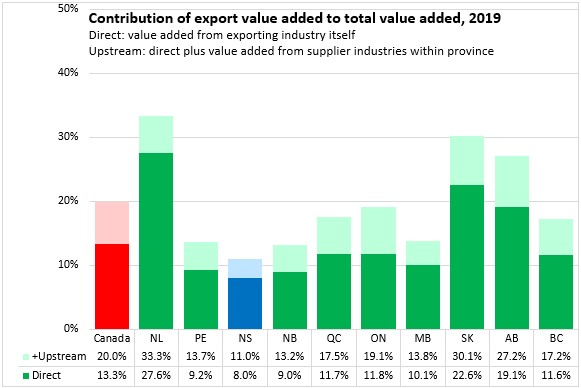
Despite its relatively low export intensity, the amount of direct value added measured as a share of total exports in Nova Scotia (42.1%) is comparable to the national average (42.2%). Counting the value added in exports created in upstream supplier industries of the exporting sector, 58.0% of Nova Scotia's exports represent value added that generates income within the province. New Brunswick's value added share of exports is lower because of the large value of imported content in its sizable petroleum refining industry.

Nova Scotia's employment is comparatively less dependent on international exports as only 8.3% of jobs are attributable directly to exports. Including upstream jobs embodied in exports, Nova Scotia's share of employment connected to exports is 11.4% (lowest among provinces). The national average share of employment from exports is 16.0%. The highest share is in Ontario at 17.7%.
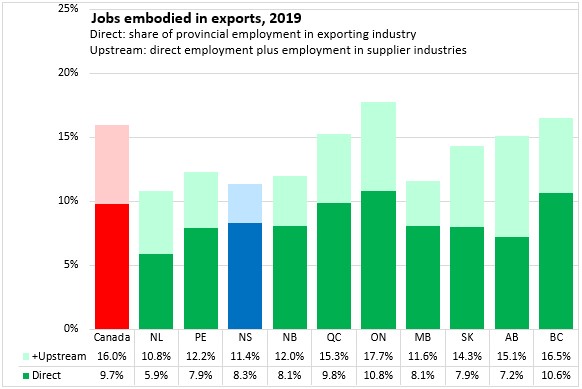
The amount of export value added per worker (directly within exporting industries) is $86,860 for Nova Scotia, well below the national average of $151,926. The national average of direct value added per worker is inflated by oil-producing provinces where export values are high relative to low employment within the oil and gas industries.
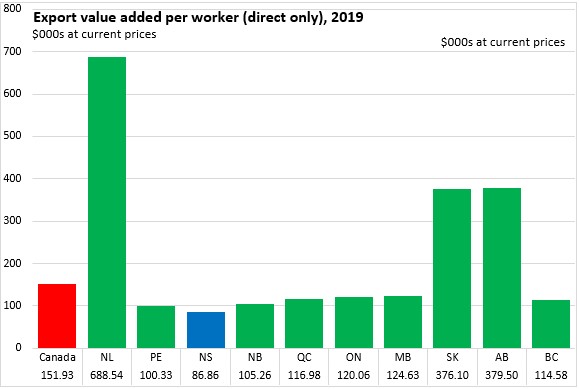
Including upstream value added to exports and upstream employment, Nova Scotia's export value added per worker is slightly higher at $87,865 per worker. However, export value added per worker in provinces with resource-intensive economies is considerably lower after including upstream workers as upstream industries are more labour-intensive than oil and gas extraction.
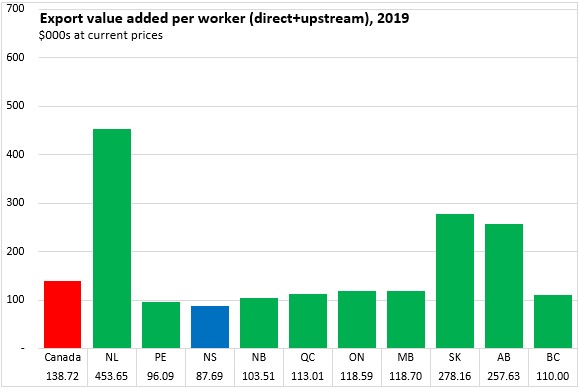
Calculating the number of workers required to generate $1 million in exports offers another perspective on the relationship between exports and employment. Nova Scotia's exports are the most labour intensive in the country requiring 6.6 jobs to generate $1 million in exports.

The value added in exports data also provides the most detailed information on the value of exports from all industries, including services. Of the total value of $8.13 billion in exports from Nova Scotia in 2019, the largest values were from manufacturing, notably rubber products ($1,249.7 million), seafood products ($1,176.5 million, not including unprocessed) and fishing/aquaculture products ($850.4 million). Transportation services ($618.3 million), forest products ($565.6 million), wholesale trade ($532.5 million), accommodation/food services ($414.6 million) and aerospace products ($292.5 million) contributed the next largest exports.
From its exports, Nova Scotia generated $4.71 billion in added value, including the exporting industry as well as upstream industries within the province.
The chart below illustrates the amount of value added generated within each exporting industry as well as the value added generated in upstream industries.
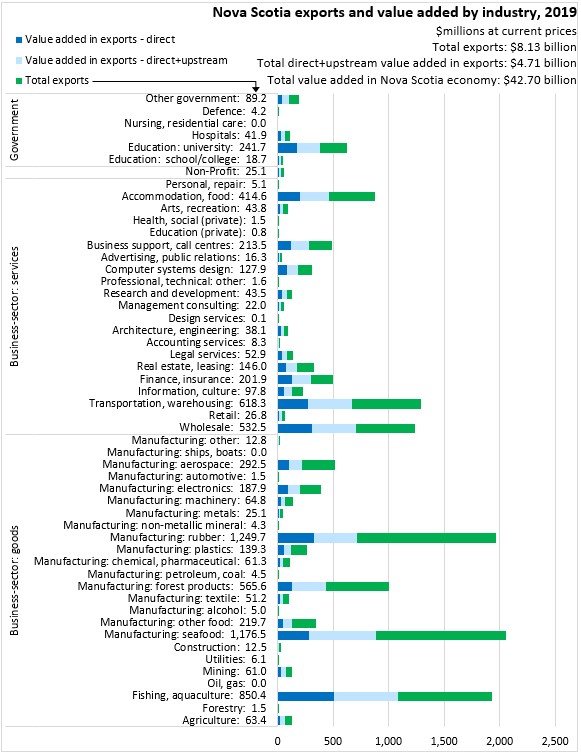
Statistics Canada estimates that in 2019 39,370 jobs were directly attributable to exports from all industries. Including upstream industries, 53,757 jobs in Nova Scotia depended on exports. Seafood processing exports generated 7,265 jobs in 2019. The next largest contributions of exports to employment were reported in accommodation/food (6,377), wholesale trade (4,887), fishing/aquaculture (4,390), transportation/warehousing (4,318), rubber products manufacturing (3,978) and forest products (2,755).

With fewer imported inputs, exports of services generally had higher value added portions of total exports than exports of goods.
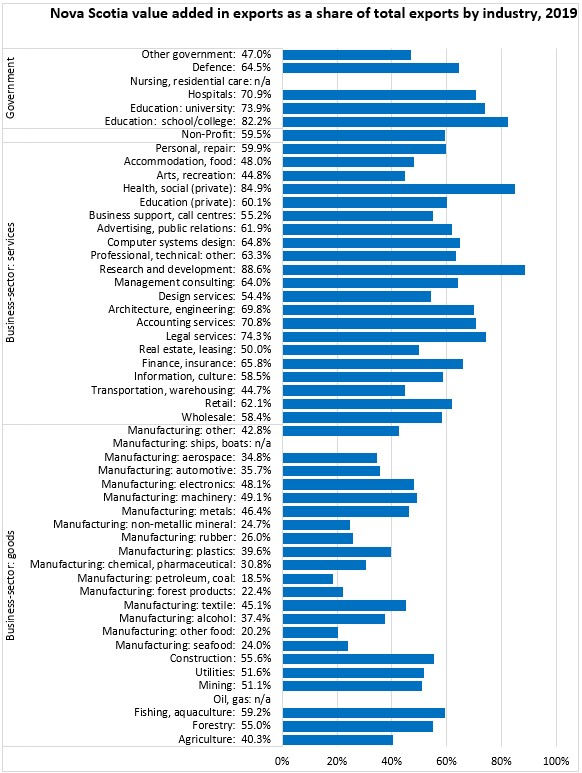
Measured by the share of total employment directly attributable to exports, the most export intensive industries in Nova Scotia were seafood product manufacturing, rubber product manufacturing, fishing/aquaculture, research and development services and electronics manufacturing.

Statistics Canada's value added in exports also provides data on imports by sector as well, allowing the assessment of a trade balance by industry. Nova Scotia's imports are heavily concentrated in manufactured products, notably: automotive, electronics, chemical/pharmaceutical, machinery, metals, food and refined petroleum. With relatively little production in these industries (except food), Nova Scotia has a substantial trade deficit in these products, with imports in excess of exports. Nova Scotia's products and services with trade surplus include: agriculture, fishing/aquaculture, seafood processing, forest products, rubber products, wholesale trade, transportation/warehousing, accommodation/food services and university education.
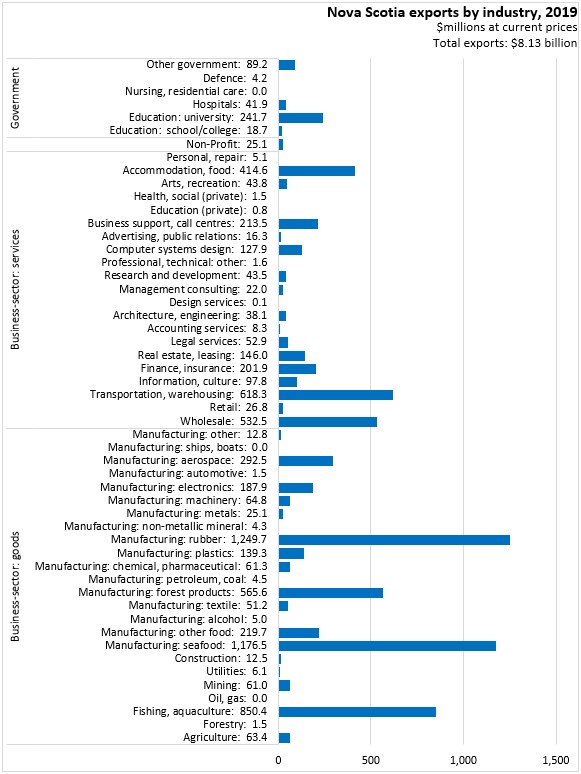
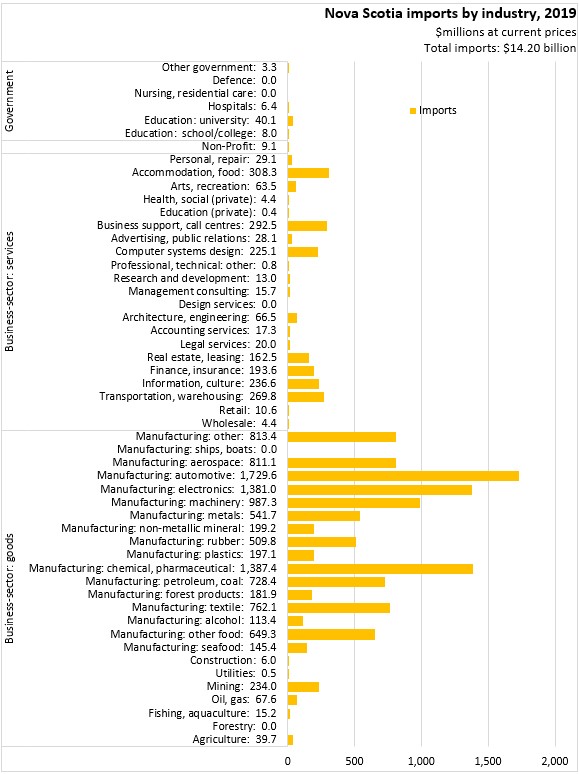

Statistics Canada: Table 12-10-0100-01 Value added in exports, by industry, provincial and territorial
<--- Return to Archive